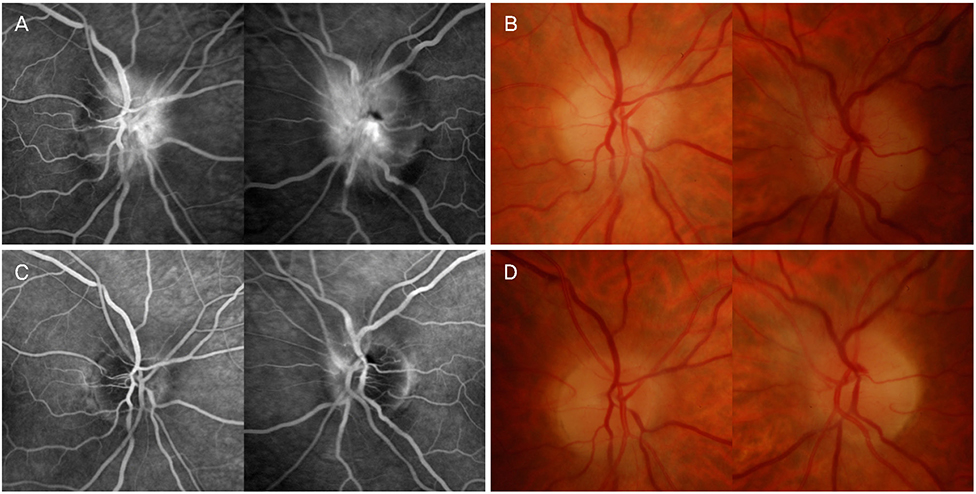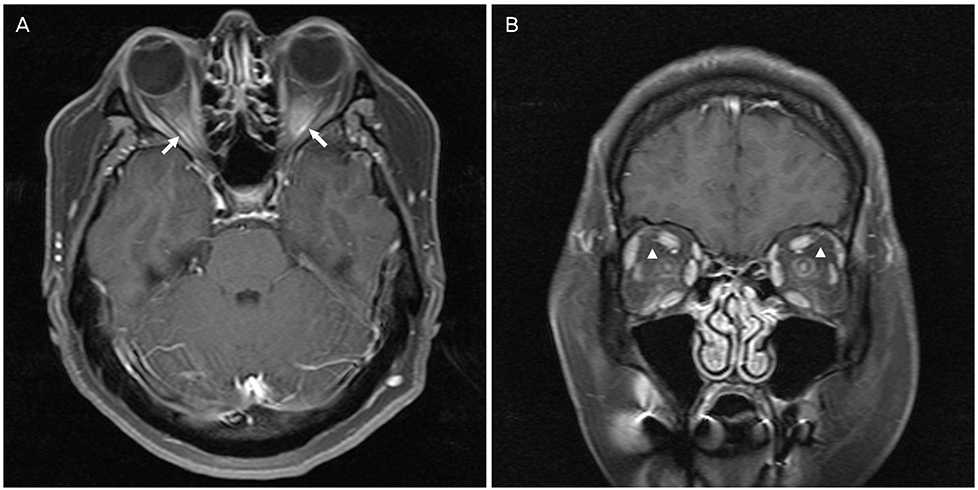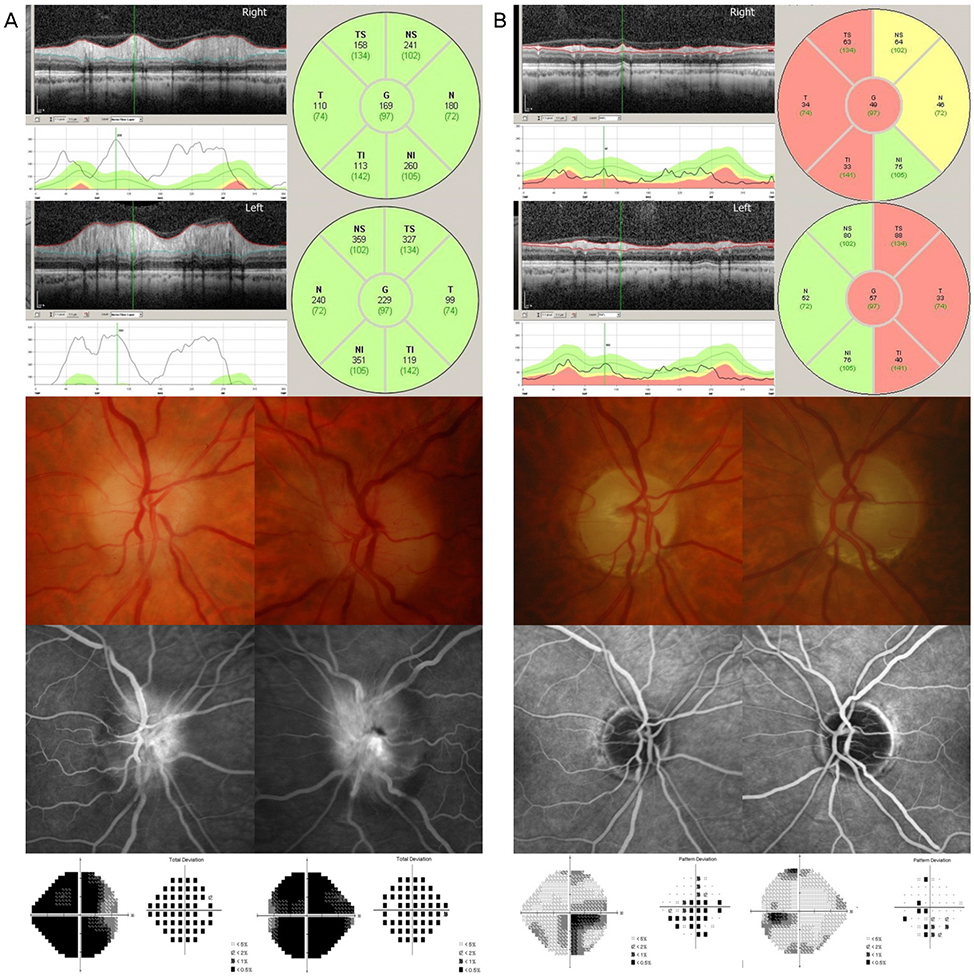J Korean Ophthalmol Soc.
2019 Jun;60(6):600-605. 10.3341/jkos.2019.60.6.600.
Optic Neuritis Accompanied by Optic Perineuritis after Peribulbar Retinalamin Injection
- Affiliations
-
- 1Department of Ophthalmology, Soonchunhyang University Seoul Hospital, Soonchunhyang University College of Medicine, Seoul, Korea. sjha@schmc.ac.kr
- KMID: 2449715
- DOI: http://doi.org/10.3341/jkos.2019.60.6.600
Abstract
- PURPOSE
To report a case of optic neuritis accompanied by optic perineuritis after retinalamin peribulbar injection.
CASE SUMMARY
A 46-year-old Kazakhstan woman presented with sudden vision loss, headache, and pain in both eyes which began 2 hours after the peribulbar injection of retinalamin approximately 10 days prior to her initial visit. At the initial visit, the best-corrected visual acuity was light perception in both eyes. A fundus examination showed bilateral optic disc swelling and fluorescein angiography showed late-phase leakage around the optic nerve and optic nerve sheath enhancement. On brain magnetic resonance imaging, the tram track sign and donut sign were seen in both eyes. Steroid pulse therapy was started after the diagnosis of optic neuritis accompanied by optic perineuritis. After 6 months, the patient's visual acuity improved up to 0.8 in the right eye and 1.0 in the left eye. The light reflex was recovered, the relative afferent pupillary defect decreased, and there was no evidence of optic disc swelling.
CONCLUSIONS
When an unverified drug injection is performed (e.g., retinalamin), it could result in complications such as optic neuritis and optic perineuritis from an allergic reaction or peribulbar injection trauma. In such cases, high-dose steroid pulse therapy may be considered.
MeSH Terms
Figure
Reference
-
1. Beck RW, Gal RL, Bhatti MT, et al. Visual function more than 10 years after optic neuritis: experience of the optic neuritis treatment trial. Am J Ophthalmol. 2004; 137:77–83.2. Optic Neuritis Study Group. Multiple sclerosis risk after optic neuritis: final optic neuritis treatment trial follow-up. Arch Neurol. 2008; 65:727–732.3. Purvin V, Kawasaki A, Jacobson DM. Optic perineuritis: clinical and radiographic features. Arch Ophthalmol. 2001; 119:1299–1306.4. Khavinson VK, Kuznik B, Ryzhak G. Peptide bioregulators: a new class of geroprotectors. Message 1: results of experimental studies. Adv Gerontol. 2013; 3:225–235.
Article5. Khavinson VK, Malinin V, Trofimova S, Zemchikhina VN. Inductive activity of retinal peptides. Bull Exp Biol Med. 2002; 134:482–484.6. Frisén L. Swelling of the optic nerve head: a backstage view of a staging scheme. J Neuroophthalmol. 2017; 37:3–6.
Article7. Kennerdell JS, Dresner SC. The nonspecific orbital inflammatory syndromes. Surv Ophthalmol. 1984; 29:93–103.
Article8. Optic Neuritis Study Group. The clinical profile of optic neuritis. Experience of the optic neuritis treatment trial. Arch Ophthalmol. 1991; 109:1673–1678.9. Daroff RB, Jankovic J, Mazziotta JC, Pomeroy SL. Bradley's neurology in clinical practice e-book. 1st ed. Kidlington: Elsevier Health Sciences;2015. p. 163–178.10. Edmunds W, Lawford J. Examination of optic nerve from cases of amblyopia in diabetes. Trans Ophthalmol Soc U K. 1883; 3:160–162.11. Fay AM, Kane SA, Kazim M, et al. Magnetic resonance imaging of optic perineuritis. J Neuroophthalmol. 1997; 17:247–249.
Article12. Gordon LK. Orbital inflammatory disease: a diagnostic and therapeutic challenge. Eye (Lond). 2006; 20:1196–1206.
Article13. Lim HC, Choi HY, Choi JH, Jung JH. Clinical manifestations and treatment of idiopathic optic perineuritis. J Korean Ophthalmol Soc. 2014; 55:891–897.
Article14. Warren KG, Catz I, Shutt K. Optic neuritis anti-myelin basic protein synthetic peptide specificity. J Neurol Sci. 1992; 109:88–95.
Article15. Söderström M, Link H, Xu Z, Fredriksson S. Optic neuritis and multiple sclerosis: anti-MBP and anti-MBP peptide antibody-secreting cells are accumulated in CSF. Neurology. 1993; 43:1215–1222.




